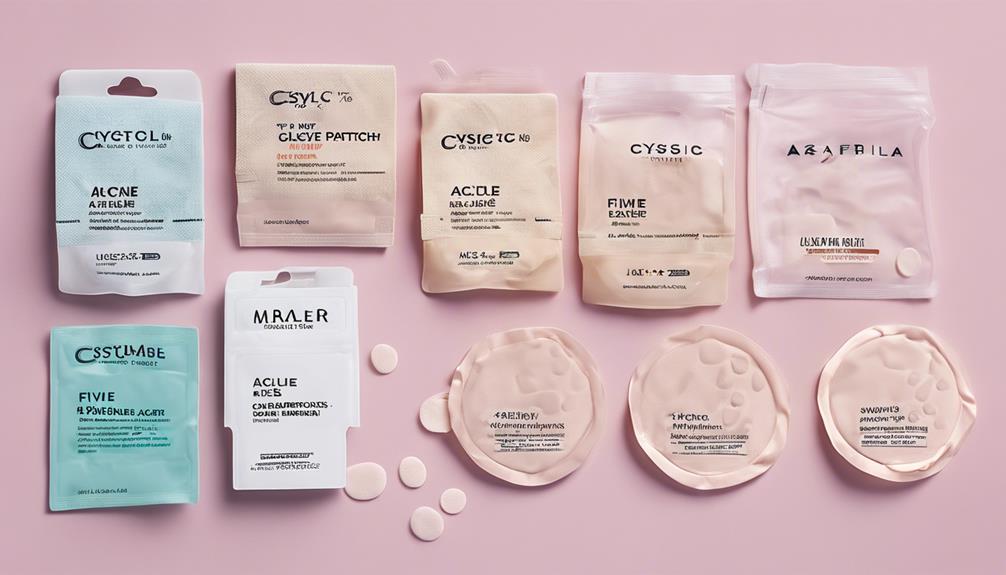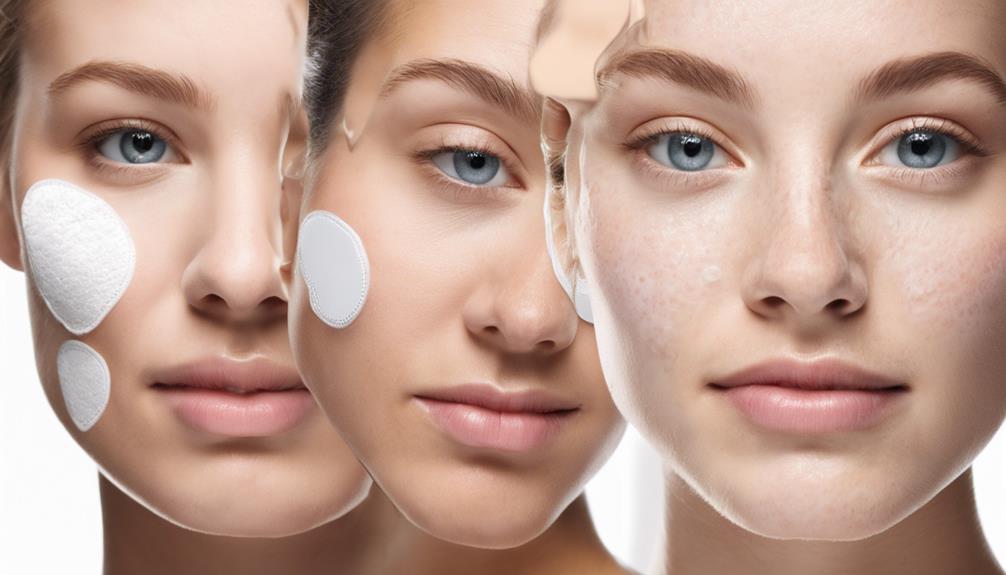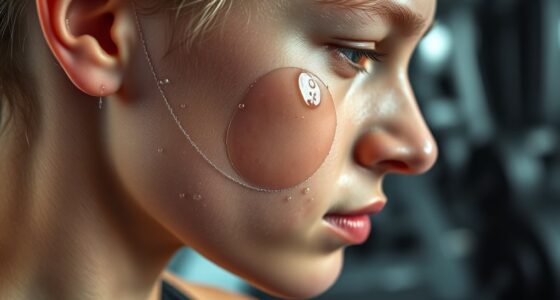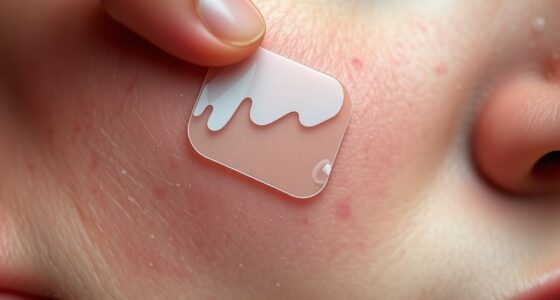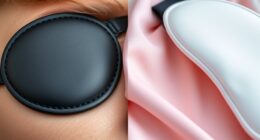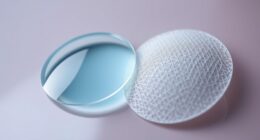Acne patches work by absorbing oil, bacteria, and pus, creating an optimal healing environment and helping to prevent further infection. These patches, often made with hydrocolloid material, extract impurities and support faster skin recovery. The hydrocolloid plays a crucial role in the treatment by improving the healing process, establishing a protective barrier, and absorbing impurities. Salicylic acid and tea tree oil are typical components that aid in maintaining a clean, moist environment, facilitating an effective healing process. By utilizing these patches, you can target bacterial growth within the acne lesion and encourage clearer skin.
Key Takeaways
- Absorb oil, bacteria, and pus for a cleaner environment.
- Create a moist, healing environment with hydrocolloid material.
- Prevent bacterial invasion and inflammation.
- Utilize ingredients like salicylic acid for antimicrobial properties.
- Promote faster skin recovery and healing process.
Understanding Acne Patches

Acne patches, a common tool in skincare routines, work by absorbing oil, bacteria, and pus from pimples using hydrocolloid material. These small, adhesive patches create a favorable environment over the pimple, promoting faster healing of the skin. By drawing out impurities, such as bacteria and excess oil, these acne patches help to maintain a clean environment for the skin to heal. Although they don't contain active acne-fighting ingredients like benzoyl peroxide, they assist in preventing further infection and reducing inflammation.
When applied to the affected area, the hydrocolloid in these patches acts as a sponge, absorbing impurities and creating an advantageous environment for the skin to heal. This process not only speeds up the recovery of individual pimples but also helps prevent the spread of bacteria, ultimately aiding in clearer skin. These patches are designed to be worn overnight and are available in various sizes to cover individual blemishes or larger problem areas, making them a versatile and effective tool in managing breakouts.
Role of Hydrocolloid in Acne Treatment
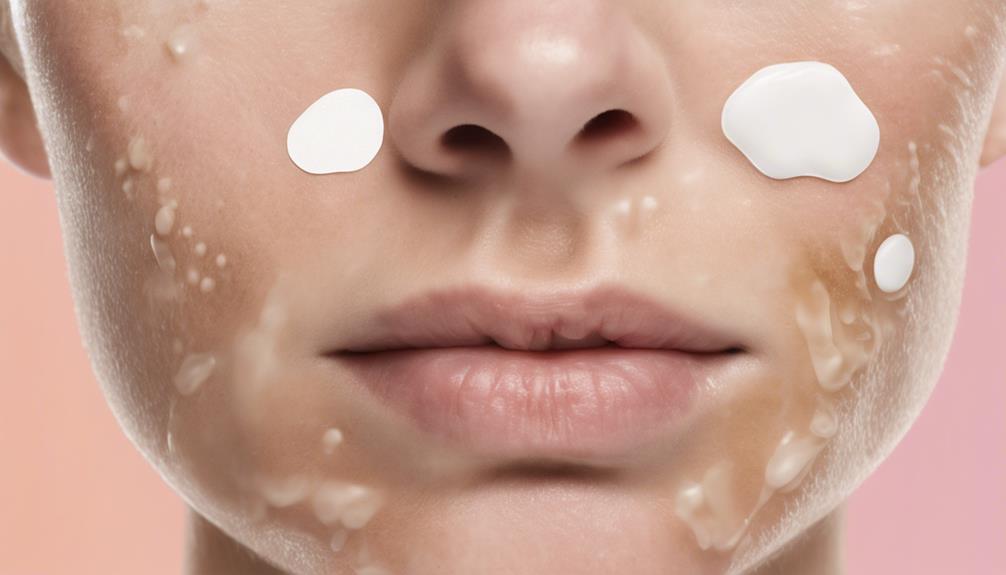
Utilizing hydrocolloid material in skincare products enhances the healing process of skin conditions by creating a protective barrier that absorbs impurities and maintains a clean environment. Hydrocolloid patches, commonly found in acne treatments, work by absorbing excess oil, bacteria, and pus from pimples. This helps in reducing inflammation and promoting faster healing of acne breakouts. The protective barrier formed by the hydrocolloid patch not only prevents further infections but also creates an ideal environment for the skin to repair itself.
In addition to absorbing impurities, hydrocolloid patches also aid in wound healing by absorbing excess fluid and promoting skin hydration. These patches have been used in medical settings for wound care since the late 1960s, showcasing their effectiveness in managing various skin conditions. Some hydrocolloid patches even include acne-fighting ingredients like benzoyl peroxide, providing additional benefits in combating acne. By understanding the role of hydrocolloid in acne treatment, individuals can make informed choices to effectively address their skincare concerns.
Mechanism of Acne Patch Action
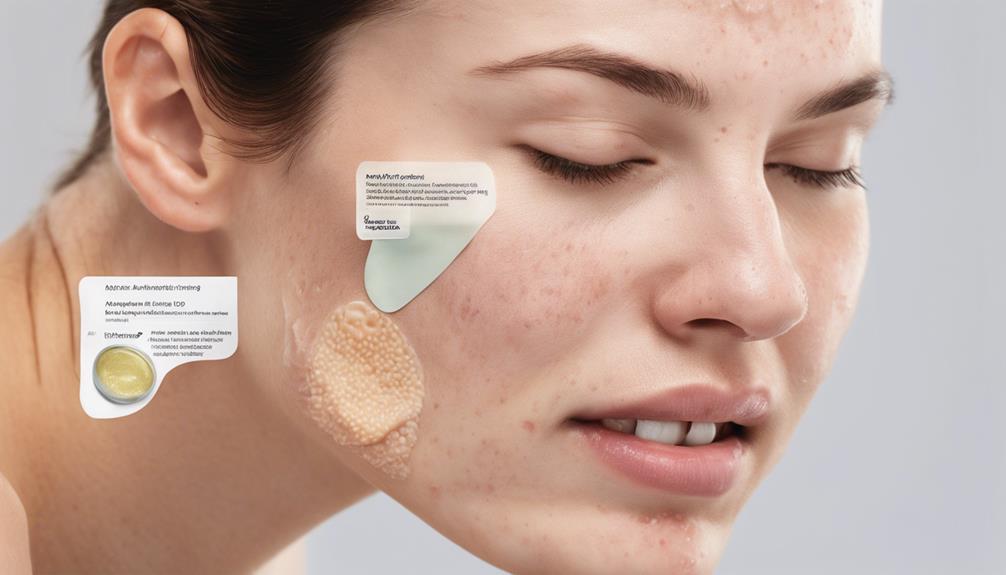
Having discussed the role of hydrocolloid in acne treatment, the mechanism of action of acne patches involves creating a protective barrier over pimples to promote faster healing and prevent bacterial infection. These patches utilize active ingredients like Salicylic acid and tea tree oil to target specific skin concerns and aid in the healing process. Here are some key points about how acne patches work:
- Hydrocolloid Pimple Patches: These patches contain hydrocolloid material that absorbs excess oil, dirt, and pus from pimples, helping prevent breakouts.
- Salicylic Acid and Tea Tree Oil: Some acne patches incorporate these active ingredients to address specific skin issues and encourage clearer skin.
- Moist Environment: Acne patches maintain a moist environment over pimples, which prevents scabbing and reduces the risk of scarring.
- Adhesive: The adhesive on acne patches ensures they stay in place, allowing for effective absorption of impurities and promoting skin regeneration.
- Healing Process: By creating a barrier, acne patches support the skin's natural healing process, leading to faster recovery and improved skin health.
Absorption of Oil and Bacteria

By actively absorbing excess oil and bacteria from the affected area, acne patches facilitate a cleaner environment for faster healing and reduced inflammation. Hydrocolloid patches, containing ingredients like salicylic acid, work by drawing out impurities, including oil and bacteria, which contribute to the formation of acne. This absorption process not only helps in clearing the pimple but also prevents further contamination, creating a barrier against external pollutants. By targeting the root cause of acne, these patches aid in minimizing inflammation and promoting a conducive environment for the skin to heal efficiently.
The absorption of oil and bacteria by acne patches plays a crucial role in the overall effectiveness of these skincare products. It not only helps in reducing the size and redness of the pimple but also supports the healing process by maintaining a clean environment. This mechanism of action highlights the importance of keeping the affected area free from excess oil and harmful bacteria, ultimately leading to clearer and healthier skin.
Benefits of Overnight Application

As we explore the benefits of overnight application of acne patches, it becomes evident that extended contact time with the pimple maximizes the absorption of oil, bacteria, and pus. Here are some advantages of using acne patches overnight:
- Faster Healing: Prolonged wear overnight creates a moist environment that promotes faster healing and reduces inflammation.
- Prevent Touching: Acne patches worn overnight act as a barrier, preventing the temptation to touch or pick at the pimple, reducing the risk of further irritation or infection.
- Extended Wear Time: The extended duration of wear during sleep allows the patch to effectively draw out impurities and aid in skin recovery.
- Discreet: Overnight application is a discreet way to address pimples, allowing the patch to work actively during the body's natural repair processes without drawing attention.
- Enhanced Effectiveness: The extended contact time enhances the patch's effectiveness in treating the pimple and improving skin condition.
Healing Blemishes With Patches
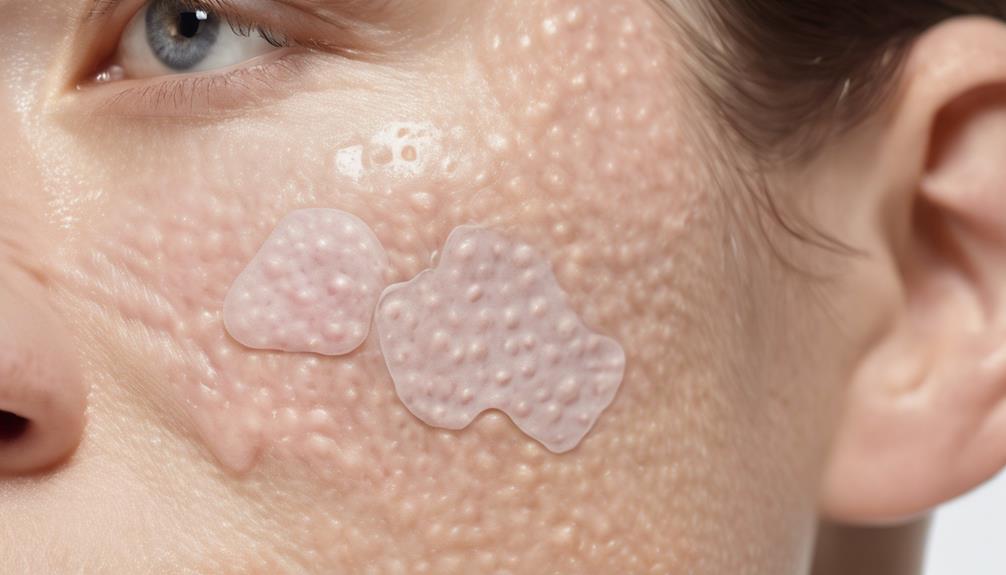
Acne patches function by adhering to the skin and absorbing excess oil, bacteria, and pus from blemishes. This process aids in cleansing the pores and promoting quicker healing while reducing inflammation.
The hydrocolloid material in the patches creates a favorable moist environment for the skin to recover, facilitating the natural healing process.
Patch Mechanics Explained
To grasp how acne patches work to heal blemishes, it's essential to explore the mechanics behind these innovative skincare products.
- Acne patches create a protective barrier over the blemish, preventing infection and promoting faster healing.
- They absorb excess oil, bacteria, and pus from the pimple, reducing inflammation and redness.
- Patches with hydrocolloid material draw out fluids from the pimple, maintaining a clean and moist environment for healing.
- Some patches contain salicylic acid or tea tree oil to target specific acne concerns and enhance the healing process.
- Research indicates that acne patches improve the appearance of pimples and aid popped pimples in healing faster, making them effective for managing breakouts.
Pore Cleansing Benefits
Exploring the pore-cleansing benefits of acne patches reveals their effectiveness in promoting faster healing and reducing inflammation by drawing out impurities from blemishes. These patches create a protective barrier that prevents infections by keeping external bacteria at bay.
By absorbing excess oil and pus, they aid in pore cleansing, improving the appearance of blemishes. Maintaining a vital environment is essential for skin repair, as it helps prevent scabbing and crusting, ultimately promoting faster healing.
Hydrocolloid patches, in particular, excel at drawing out impurities from pores, contributing to reduced inflammation. Research indicates that using acne patches not only aids in pore cleansing but also accelerates the healing process of pimples, leading to clearer and healthier skin.
Preventing Bacterial Infections
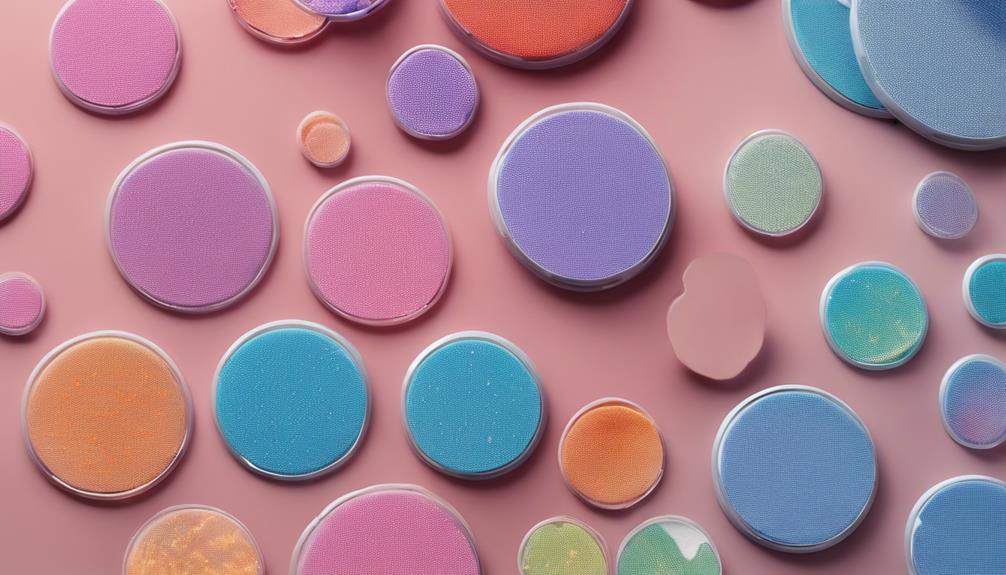
By creating a protective barrier, acne patches effectively prevent bacterial infections from contaminating the pimple. Here are some key points on how acne patches help in preventing bacterial infections:
- Acne patches help absorb oil and bacteria from the pimple, reducing the risk of infection and promoting faster healing.
- Hydrocolloid patches specifically target preventing bacterial growth within the acne lesion.
- By keeping the pimple covered and protected, acne patches minimize the risk of bacterial invasion and subsequent inflammation.
- The gel-like material in acne patches absorbs excess fluids, including bacteria, to maintain a clean and hygienic environment for the pimple to heal.
- Benzoyl peroxide or salicylic acid in acne patches also contribute to preventing bacterial infections by their antimicrobial properties.
These functions collectively illustrate how acne patches work to not only treat existing pimples but also prevent further complications by creating a conducive environment for the skin to heal efficiently.
Non-Invasive Acne Management

Let's explore how acne patches provide a gentle yet effective approach to managing acne without invasive procedures.
Hydrocolloid patches, a key player in non-invasive acne management, work by creating a barrier that absorbs excess oil, bacteria, and pus from pimples. By doing so, they help treat acne, heal the skin, and prevent infection. These patches maintain a moist environment, promoting skin recovery and preventing further irritation.
Some patches contain salicylic acid, which can address specific acne concerns while aiding in skin healing. Clinical trials have demonstrated the effectiveness of acne patches in improving the appearance of pimples and accelerating the healing process, making them a valuable option for non-invasive acne management.
With their ability to absorb impurities, promote healing, and prevent further skin damage, hydrocolloid patches offer a simple yet powerful solution for those seeking to manage acne gently and effectively.
Promoting Faster Skin Recovery

Acne patches facilitate expedited skin recovery by creating a protective barrier that aids in absorbing excess oil, dirt, and pus from pimples. This protective barrier helps promote healing and prevents further irritation, allowing for faster resolution of acne. Here are some key ways in which acne patches enhance the healing process:
- Absorb Excess Oil: By absorbing excess oil from the pimple, acne patches help in maintaining a clean environment for healing.
- Prevent Irritation: The barrier created by acne patches protects the acne lesion from external aggressors, reducing the risk of irritation.
- Enhance Healing Process: Some patches contain ingredients that can accelerate the healing process by promoting exfoliation and revealing healthier skin.
- Promote Healing: Acne patches aid in promoting the natural healing process of the skin, allowing for quicker recovery.
- Acne Lesion Protection: The primary function of acne patches is to shield the acne lesion from bacteria and prevent picking, supporting the skin's natural healing mechanisms.
Easy Application of Acne Patches

We find it straightforward to apply acne patches after properly cleansing and drying the affected area. Following the instructions on the label is key for effective application. Simply peel off the patch and gently place it over the pimple. For some patches, repeated application may be necessary to maximize benefits.
Most acne patches are designed for overnight use, typically worn for 6-8 hours, allowing for uninterrupted treatment while you sleep. By creating a clean and moist environment over the pimple, these patches facilitate faster healing. Ensuring the skin is free from dirt and oil before application is essential for the patch to adhere properly.
The simplicity of using acne patches makes them a convenient option for promoting skin recovery. With easy application steps and the potential for faster healing, acne patches offer a hassle-free solution for addressing pesky pimples.
Maintaining Clearer Skin With Patches

After understanding the easy application of acne patches, maintaining clearer skin with these patches becomes a practical way to manage breakouts and promote skin health. Pimple patches offer several benefits that contribute to healthier skin:
- Shielding: Patches create a barrier that shields pimples from external elements and prevents infection-causing bacteria from aggravating the condition.
- Absorption: They help in absorbing excess oil and bacteria from within the pimple, aiding in faster healing and reducing inflammation.
- Hydrocolloid Technology: Utilizing hydrocolloid technology, these patches have been used in medical settings for wound care, promoting a moist environment for faster healing.
- Promoting Healing: While not containing ingredients like benzoyl peroxide, patches assist in managing breakouts by promoting a clean environment for the skin to heal effectively.
- Convenience: Designed to be worn overnight, these patches come in various sizes catering to individual blemishes or larger problem areas, providing a convenient and targeted skincare solution.
Enhancing At-Home Acne Care

Enhancing our at-home acne care routine can be effectively achieved with the use of acne patches. These patches, particularly hydrocolloid patches, play an essential role in protecting and healing breakouts. By forming a barrier, they not only absorb excess oil but also prevent picking, ultimately leading to faster healing of acne. Salicylic acid, often present in these patches, aids in unclogging pores and reducing inflammation.
To illustrate the benefits of acne patches, let's take a closer look at their functions:
| Acne Patch Benefits | How They Help | Key Ingredients |
|---|---|---|
| Protect Pimples | Shield against external bacteria | Hydrocolloid |
| Heal Breakouts | Aid in faster healing | Salicylic acid |
| Absorb Excess Oil | Reduce inflammation and redness | |
| Prevent Picking | Improve outcomes and resolution |
Incorporating these acne patches into your skincare routine can enhance your acne care regimen, promoting clearer and healthier skin.
Frequently Asked Questions
Do Pimple Patches Work on Unpopped Pimples?
Pimple patches may not work as effectively on unpopped pimples since they're designed to absorb fluid from open or popped ones. Unpopped pimples mightn't provide enough fluid for the patch to work at its best.
The adhesive on the patch may not stick well on unpopped pimples, reducing its effectiveness. To enhance results, consider using other acne treatments like salicylic acid before applying a patch.
Do Acne Patches Actually Work?
Yes, acne patches do work.
Clinical trials have proven their efficacy in improving the appearance of pimples and speeding up the healing process of popped pimples.
By creating an ideal healing environment and enhancing the penetration of topical treatments, acne patches are a valuable tool in managing acne.
Starting treatment early can prevent further irritation and promote faster recovery.
Why Do Pimple Patches Turn White?
When pimple patches turn white, it's a sign that they're absorbing oils, bacteria, and pus. This transformation indicates that the patch is actively drawing out impurities and excess sebum from the pimple.
The white color change is a visible signal that the patch is doing its job of absorbing and treating the blemish. Seeing the white gunk on the patch after use demonstrates its effectiveness in removing impurities from the skin.
What Do Pimple Patches Pull Out?
Pimple patches pull out excess oil, bacteria, and pus from acne lesions. The hydrocolloid material in pimple patches absorbs fluids and impurities from pimples. They help maintain a clean and moist environment, promoting faster healing.
Pimple patches effectively pull out and trap impurities without causing skin irritation. Studies show that pimple patches can visibly pull out debris and reduce inflammation in acne lesions.
Conclusion
To sum up, acne patches work by absorbing oil and bacteria, promoting faster skin recovery, and maintaining clearer skin. Additionally, they create a protective barrier over blemishes, reducing the temptation to pick or touch the affected area. This not only minimizes the risk of scarring but also helps to keep the skin hydrated and prevent further breakouts. Overall, the benefits of acne patches make them an effective tool for managing acne-prone skin.
Like a shield protecting a warrior in battle, acne patches provide a barrier against harmful elements, allowing the skin to heal and rejuvenate overnight.
With easy application and proven benefits, acne patches are a valuable addition to at-home acne care routines.
So, next time you face a pimple battle, trust in the power of acne patches to help you win the war against breakouts.

